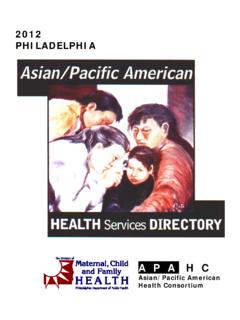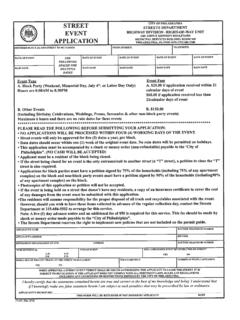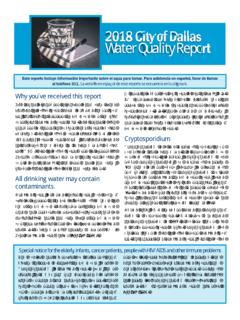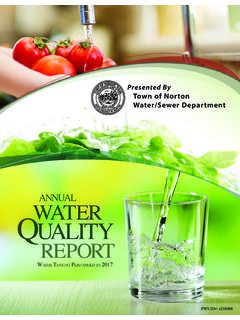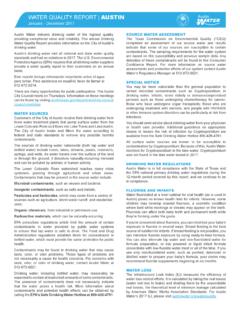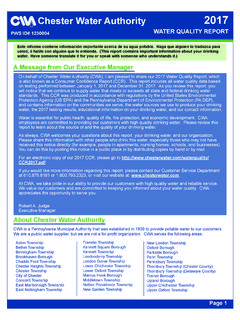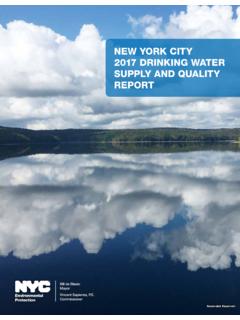Transcription of 2017 Drinking Water Quality Report (published Spring 2018)
1 2017 . Drinking Water Quality Report Published Spring 2018. This Report is produced as a requirement of the Federal Safe Drinking Water Act. Note: Industrial and commercial customers, including hospitals, medical centers and health clinics, please forward this Report to your Environmental Compliance Manager. PWD's Public Water System Identification #PA151001. We continue to deliver safe, reliable, high- Quality Drinking Water from source to tap. Our Drinking Water Quality is better than standards set by the EPA. Philadelphia Water Department | 2017 Drinking Water Quality Results Table of Contents 4 Sharing This Report 11 Partnership for Safe Water 19 Glossary 4 People with Special Health 12 Pharmaceuticals and Source 20 Your Support Means More Concerns Water Green Milestones 5.
2 A Message from the 12 Cryptosporidium and Giardia 21 Fairmount Water Works: Philadelphia Water Innovation and Education Department's Commissioner 13 Schuylkill and Delaware River Continues . Source Water Protection Plans 6 Where Does Philadelphia's 22 Clean Water Begins and Ends Drinking Water Come From? 14 Water Treatment Diagram with You 7 Safeguarding the Water You 16 Monitoring Water Quality : Drink What Do We Look For? 8 Lead in Drinking Water 16 2017 Drinking Water Quality Results Sharing This Report People With Special Health Concerns Please share this Report with all people who drink this Water , Some people may be more vulnerable to contaminants especially those who may not have received this notice in Drinking Water than the general population. Immuno- directly (for example, people in apartments, nursing homes, compromised persons, such as persons with cancer schools and businesses).
3 You can do this by posting this undergoing chemotherapy, persons who have undergone notice in a public place or distributing copies by hand and organ transplants, people with HIV/AIDS and other immune mail. system disorders, some elderly and infants can be particularly at risk from infections. These people should seek advice about To receive a printed copy of this Report , please email: Drinking Water from their health care providers. Environmental Protection Agency (EPA)/Centers for Para obtener una copia del informe en Espa ol sobre los Disease Control (CDC) guidelines on appropriate means to resultados m s recientes de la calidad del agua publicado lessen the risk of infection by Cryptosporidium and other por el Departamento de Agua de Philadelphia, llame al microbial contaminants are available from the Safe Drinking Water Hotline: 4 | 1101 Market Street Philadelphia, PA 19107 2994.
4 A Message From the Philadelphia Water Department's Commissioner Every hour of every day, we work to provide you with safe, reliable service and Water that tastes good and that you can trust. Our staff of over 2,000. dedicated employees work to ensure that our Water exceeds safe Water standards and remains top Quality . This Report , published in the Spring of 2018, includes Water Quality information for the 2017 calendar year. The Environmental Protection Agency (EPA) requires all Water utilities to produce and distribute Water Quality reports on an annual basis. We take this opportunity to introduce you to a variety of programs and operations that preserve and protect our Drinking Water sources the Schuylkill and Delaware rivers. Through continuous treatment, testing and monitoring, the Water that leaves our treatment plants is better than what is required by the EPA.
5 Our team of experienced scientists and engineers tests our Water for nearly 100 compounds. This annual Drinking Water Quality Report explains what we look for, and what we found. Water is one of life's essential resources, and we hope you take the time to look at all the information in the Report . Please do not hesitate to contact us if you have any questions or would like to learn more about being a part of keeping our Water and waterways clean. Debra McCarty Water Commissioner The Philadelphia Water Department is an active member of: American Water Resources Association National Association of Clean Water Agencies Water Alliance American Water Works Association Partnership for the Delaware Estuary Water Environment Federation Partnership for Safe Water Schuylkill Action Network Water Environment Research Foundation American Public Works Association Schuylkill River Restoration Fund Water Research Foundation Association of Metropolitan Water Agencies Tookany/Tacony-Frankford (TTF) Watershed Partnership Customer Contact Center: | 5.
6 Philadelphia Water Department | 2017 Drinking Water Quality Results Where Does Philadelphia's Drinking Water Come From? Philadelphia's Water comes from the Schuylkill and Delaware rivers. Each river contributes one-half of the City's overall supply and approximately 230 million gallons of high- Quality Drinking Water is produced for our customers on a daily basis. Rivers are surface Water supplies. Philadelphia does not use groundwater. The Philadelphia Water Department (PWD). has three Water treatment plants that process untreated river Water . Depending on where you live, you receive Drinking Water from one of these three plants: The Queen Lane Plant is located in East Falls and its Water comes from the Schuylkill River; its intake is located along Kelly Drive. The Belmont Plant is located in Wynnefield and its Water also comes from the Schuylkill River.
7 Its intake is located along Martin Luther King, Jr. Drive. The Baxter Plant is located in Torresdale and its Water comes from the Delaware River; its intake is located at the plant on the Delaware River. Philadelphia is located in the Delaware River Watershed, which begins in New York State and extends 330 miles south to the mouth of the Delaware Bay. The Schuylkill River is part of the Delaware River Watershed. 6 | 1101 Market Street Philadelphia, PA 19107 2994. Safeguarding The Water You Drink How Do Drinking Water Sources Become Polluted? Across the nation, rivers, lakes, streams, ponds, reservoirs, springs and wells are sources of Drinking Water (both tap Water and bottled Water ). Rain and melting snow travels over the surface of the land or through the ground, dissolving naturally occurring minerals and picking up substances resulting from animal and human activity and carrying these pollutants to our Drinking Water sources.
8 Contaminants that may be present in source Water include: Microbial contaminants, such as viruses and bacteria, from sewage treatment plants, septic systems, agricultural livestock operations and wildlife. Inorganic contaminants, such as salts and metals can be naturally occurring or come from urban stormwater runoff (streets and parking lots), industrial or domestic wastewater discharges, oil and gas production, mining or farming. Pesticides and herbicides from a variety of sources such as agriculture, urban stormwater runoff and residential uses. Organic chemical contaminants, including synthetic and volatile organic chemicals, are byproducts of industrial processes and petroleum production. They can also come from gas stations, urban stormwater runoff and septic systems. Today, Philadelphia Radioactive contaminants can be naturally occurring or can come from oil and gas production, mining activities or medical use.
9 Enjoys watersheds At their sources, the Delaware and Administration establishes limits for that are cleaner and Schuylkill Rivers are generally clean. But contaminants in bottled Water that healthier than they as the rivers flow downstream, they pick must provide the same protection for up contaminants from many sources public health. have been in well stormwater runoff washes pollutants Drinking Water , including bottled over a century. on the land into the rivers, and Water , may reasonably be expected communities and industries discharge to contain at least small amounts of used Water back into the rivers. Today, some contaminants. The presence of Philadelphia enjoys watersheds that are contaminants does not necessarily cleaner and healthier than they have indicate that Water poses a health risk.
10 Been in well over a century. Although we More information about contaminants have seen a dramatic improvement in and potential health effects can be the Water Quality of the City's two major obtained by calling the EPA's Safe rivers since the passage of the Federal Drinking Water Hotline, , Clean Water Act in the early 1970s, or from their website: there is still more work that needs to be done to protect our Drinking Water sources from pollution. In order to ensure that tap Water is safe to drink, the EPA has regulations that limit the amount of certain contaminants in Water provided by Water suppliers. The Food and Drug Customer Contact Center: | 7. Philadelphia Water Department | 2017 Drinking Water Quality Results Lead in Drinking Water The Drinking Water delivered to your home meets all state and federal Water Quality standards.
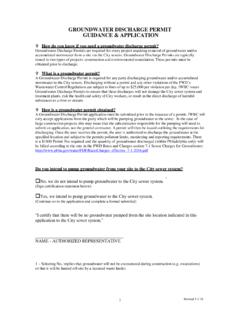
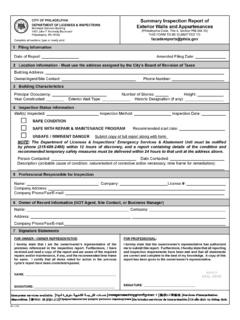
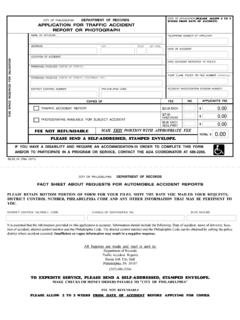
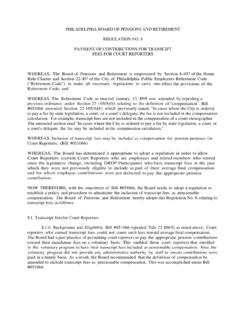
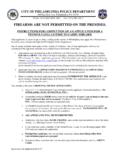
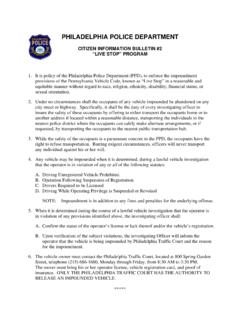
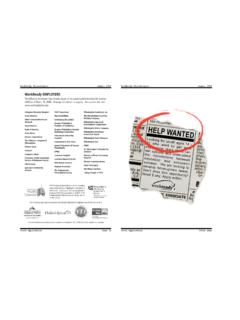
![[PSA] Philly: Classaction lawsuit brings changes in …](/cache/preview/1/4/c/8/8/d/5/c/thumb-14c88d5c5b2f1fee5e561fc7daceb397.jpg)
